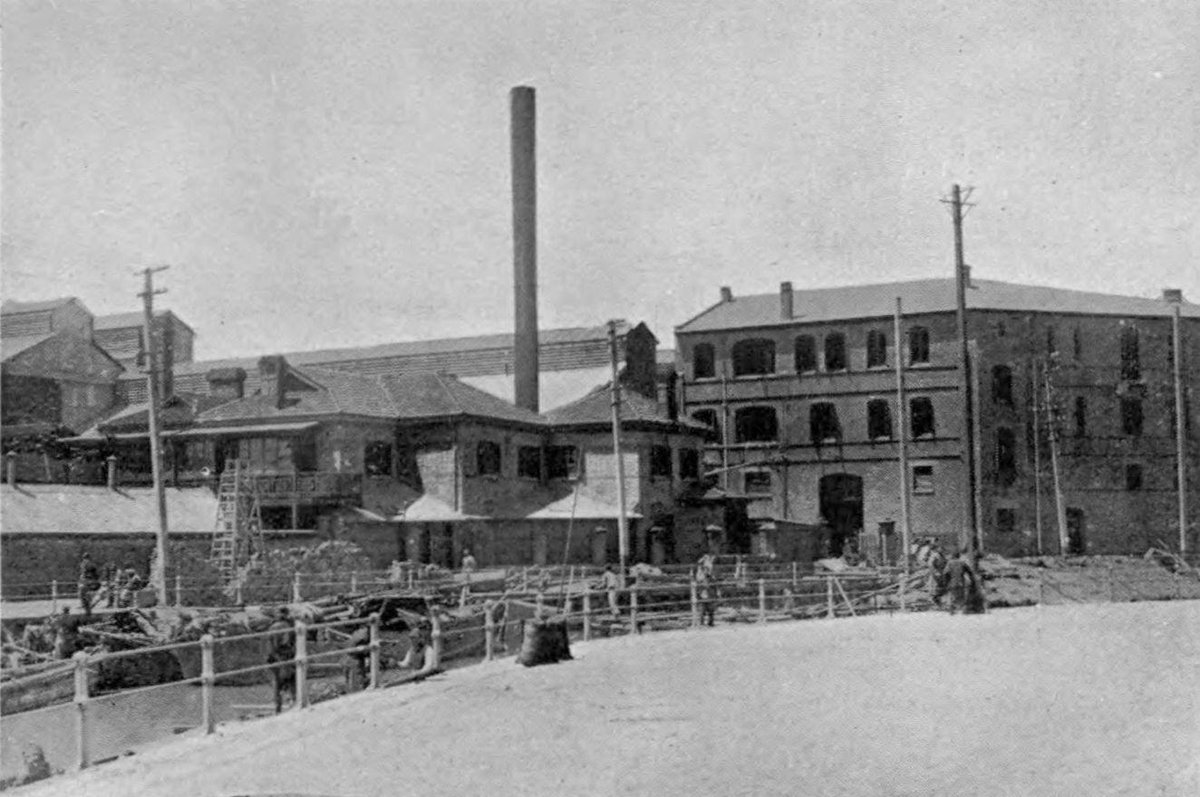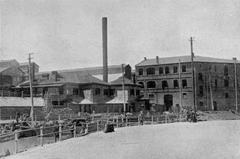
Yangshupu Power Plant: Visiting Hours, Tickets, and Complete Guide to Shanghai’s Historic Industrial Landmark
Date: 15/06/2025
Introduction
The Yangshupu Power Plant, situated on the banks of the Huangpu River in Shanghai’s Yangpu District, stands as a testament to the city’s industrial heritage and its innovative approach to urban renewal. Established in 1911, it was the first large-scale coal-fired power station in East Asia, playing a pivotal role in powering Shanghai’s factories, tramways, and residential neighborhoods. After its closure in 2010, the plant underwent a remarkable transformation, emerging as the Yangshupu Power Plant Ruins Park—a dynamic space blending preserved industrial relics, contemporary art, green public areas, and cultural amenities.
This guide offers detailed information on the site’s historical significance, architectural features, visiting hours, ticketing, accessibility, travel tips, and nearby attractions. Whether you are a history buff, architecture enthusiast, or leisure traveler, Yangshupu Power Plant is a must-see landmark that captures the essence of Shanghai’s evolution from industrial powerhouse to global metropolis.
For official updates and visitor resources, consult channels such as the Yangpu District official website and architectural project pages like BDP.
Table of Contents
- Historical Overview
- Architectural Features and Adaptive Reuse
- Cultural Significance and Urban Identity
- Visitor Information: Hours, Tickets, and Accessibility
- Travel Tips and Nearby Attractions
- Visitor Experience and Interpretation
- Frequently Asked Questions (FAQ)
- Conclusion and Resources
Historical Overview
Origins and Early Development (1911–1949)
Commissioned in 1911 and designed by British engineers, Yangshupu Power Plant pioneered large-scale electricity generation in the Far East (BDP). Its strategic location along the Huangpu River enabled efficient coal delivery and water intake, critical for operating the imported British boilers and generators. The plant quickly became essential to Shanghai’s burgeoning industrial and commercial sectors, powering factories, tramways, and street lighting during the city’s rapid modernization.
Throughout the Republican era, the plant expanded to meet growing energy demand, with its twin chimneys and red-brick facades becoming iconic elements of the Yangpu skyline.
Economic and Urban Growth (1950s–1980s)
After 1949, the plant was nationalized and integrated into China’s industrialization efforts. Its capacity continued to grow, supporting Shanghai’s heavy industries and urban infrastructure. By the 1970s, Yangshupu Power Plant reached peak output, contributing significantly to the city’s electrification and fostering a vibrant worker community with associated social amenities.
Technological Evolution and Decommissioning (1980s–2010)
Advancements in energy technology and environmental awareness led to upgrades—such as electrostatic precipitators and flue gas desulfurization—to control emissions (Trip.com). However, aging infrastructure and Shanghai’s shift toward cleaner energy sources prompted the plant’s closure in 2010, paving the way for its redevelopment.
Transformation into Ruins Park (2010–Present)
Following decommissioning, city planners and heritage advocates launched efforts to conserve the site’s architectural and industrial legacy. Major structures—including the main power station buildings, chimneys, and machinery—were preserved and repurposed. Redevelopment began in 2021, integrating the former plant into the Yangpu Riverside urban renewal project as a mixed-use park and cultural venue (BDP; Yangpu District). Today, the park seamlessly blends historic relics with green spaces, art installations, and public amenities, inviting visitors to explore Shanghai’s industrial past in a contemporary setting.
Architectural Features and Adaptive Reuse
Industrial Design and Key Structures
Spanning over 83,000 square meters, the site retains two main power station buildings, towering chimneys, coal trestles, conveyor belts, and a variety of auxiliary infrastructure (ArchDaily). Its robust architectural language—red-brick facades, steel windows, arched cement roofs—reflects both British and early Chinese industrial aesthetics.
Preserved elements such as the coal conveyors and fly ash storage tanks illustrate the engineering ingenuity of early 20th-century power production. The site’s riverside orientation facilitated coal and water delivery, an advantage now repurposed as panoramic walking paths and leisure spaces.
The Pit Art Space
A highlight of the adaptive reuse project, the Pit Art Space occupies a former deep-water storage pit. After extensive renovation, it now serves as an atmospheric venue for contemporary art, with raw industrial surfaces juxtaposed against innovative installations (ArchDaily; Jidipi). The transformation retains the authenticity of the original structure while introducing natural light and new circulation routes.
Landscape and Urban Integration
The Yangshupu Power Plant is an anchor for the broader Yangpu Riverside urban renewal, which stretches 2.7 kilometers from Yangpu Bridge to the power plant itself (Benoy). The park features themed zones—industrial relics, green spaces, art venues—connected by riverside promenades and cycling paths. Community amenities, cafes, and event spaces foster vibrant public life while maintaining the integrity of the site’s historic fabric.
Cultural Significance and Urban Identity
Yangshupu Power Plant is more than an industrial relic; it is a symbol of Shanghai’s modernization and a key node in the city’s “industrial heritage belt.” Its transformation from a closed “no-entry” production zone to an open, multifunctional public space exemplifies contemporary approaches to heritage conservation and urban innovation (Shanghai Yangpu Riverside). The site hosts art exhibitions, community events, and educational programs, serving as a platform for dialogue between past and present.
Initiatives such as the “Zero Carbon Space Café” demonstrate a commitment to environmental sustainability and social engagement, reimagining the legacy of energy production for a low-carbon future (Shanghai Yangpu Riverside).
Visitor Information: Hours, Tickets, and Accessibility
Visiting Hours
- Ruins Park and Outdoor Areas: Open daily from early morning until dusk (typically 8:00 AM–8:00 PM).
- Historical Exhibition Room: Free group visits are available Monday, Wednesday, and Friday, 9:00–11:00 AM and 1:00–3:00 PM. Advance booking required for group and volunteer-guided visits (Shanghai Government).
- Special Exhibitions: Hours may vary; check the Yangpu District official website for updates.
Tickets
- Park Entry: Free for outdoor areas and general access.
- Special Exhibitions/Interior Venues: Some may require tickets (typically 80 RMB for adults, with discounts for students, seniors, and children; children under 6 enter free). Book online or at the entrance.
Accessibility
- Fully wheelchair accessible, with ramps, elevators, and smooth pathways throughout.
- Assistance available on request; guided tours can accommodate visitors with special needs.
Getting There
- Metro: Line 4 to Yangshupu Road Station or Dalian Road Station (Line 4/12), then a short walk.
- Bus: Several routes serve the Yangpu Riverside area.
- Bike/Walk: Riverside promenades and cycling paths connect to adjacent neighborhoods.
- Car: Limited parking available; public transport is recommended.
Travel Tips and Nearby Attractions
Tips for Visitors
- Best Seasons: Spring (March–May) and autumn (September–November) offer mild weather and lush scenery.
- Photography: Early mornings and late afternoons provide excellent lighting for photos of the iconic chimneys and river views.
- Amenities: Cafes, restrooms, shaded seating, and sports facilities (basketball, volleyball, roller-skating) are available.
- Language: Bilingual signage; English-speaking staff may be limited—translation apps recommended.
- Souvenirs: Gift shops offer items reflecting Shanghai’s industrial past.
Nearby Attractions
- Shanghai Fashion Center: Contemporary design complex in repurposed industrial buildings.
- Soap Dream Space Museum: Focused on the city’s industrial and everyday life history.
- Fuxing Island Park: Riverside green space ideal for cycling or walking.
- West Bund and Oil Tank Art Center: Other notable examples of industrial heritage adaptation in Shanghai (Trip.com).
Visitor Experience and Interpretation
Industrial Heritage Interpretation
Interpretive panels, digital displays, and preserved machinery throughout the site narrate the story of China’s electrification and the lives of workers who powered Shanghai’s growth (Shine News). Occasional guided tours (especially during festivals or art events) and documentaries deepen the historical connection.
Art and Cultural Events
The park hosts vibrant cultural programming, including the biennial Shanghai Urban Space Art Season, with installations and performances in repurposed industrial spaces (Yangpu District).
Readable Architecture
A core principle of the park’s design is to keep buildings “readable”—allowing visitors to intuitively understand their original function and evolution through interpretive design and minimal intervention (Shanghai Yangpu Riverside).
Frequently Asked Questions (FAQ)
Q: What are the Yangshupu Power Plant visiting hours?
A: The park is generally open daily from early morning to dusk (about 8:00 AM–8:00 PM). The historical exhibition room is open for group visits Monday, Wednesday, and Friday—advance booking required.
Q: Is admission free?
A: Entry to the park and most outdoor areas is free. Some exhibitions or interior spaces may require paid tickets.
Q: How do I get to Yangshupu Power Plant?
A: Take Metro Line 4 to Yangshupu Road or Dalian Road Station (Line 4/12), then walk. Multiple bus lines serve the area.
Q: Is the park accessible for people with disabilities?
A: Yes, with barrier-free paths, accessible restrooms, and seating.
Q: Are guided tours available?
A: Yes, for group visits and during special events. Volunteer guides can be booked in advance.
Q: What are the best nearby attractions?
A: Shanghai Fashion Center, Soap Dream Space Museum, Fuxing Island Park, and West Bund cultural district.
Visuals and Interactive Elements
For virtual tours, maps, and high-quality images of the site—including the twin chimneys, Pit Art Space, and riverside promenades—visit the Yangpu District official site or explore the ArchDaily feature. Images are tagged with relevant keywords to enhance online searchability.
Conclusion
The Yangshupu Power Plant Ruins Park is a shining example of how industrial heritage can be preserved and revitalized for contemporary urban life. With its unique blend of history, architecture, art, and green space, it offers an enriching experience for visitors of all ages and interests. Free entry, accessibility, and abundant cultural programming make it a standout among Shanghai historical sites.
Call to Action
Download the Audiala app for guided tours, event updates, and exclusive content about the Yangshupu Power Plant and other Shanghai attractions. Stay connected via social media for the latest news, or consult the Yangpu District official website for current events and exhibitions. Plan your visit today and discover the compelling intersection of history, culture, and urban innovation at one of Shanghai’s most iconic riverfront landmarks.
References
- Exploring Yangshupu Power Plant Ruins Park: History, Visitor Info, and Shanghai’s Industrial Heritage (Trip.com)
- Visiting Yangshupu Power Plant: Hours, Tickets, and Shanghai’s Historic Industrial Landmark (BDP)
- Yangshupu Power Plant Visiting Hours, Tickets & Shanghai Historical Sites Guide (Shanghai Government)
- Visiting Yangshupu Power Plant: Hours, Tickets, and Shanghai’s Historic Riverside Site (Yangpu District Official Website)
- Pit Art Space Transformation (ArchDaily)
- Urban Space Art Season and Cultural Events (Shine News)
- Yangpu Riverside Urban Renewal Project (Benoy)






















































































